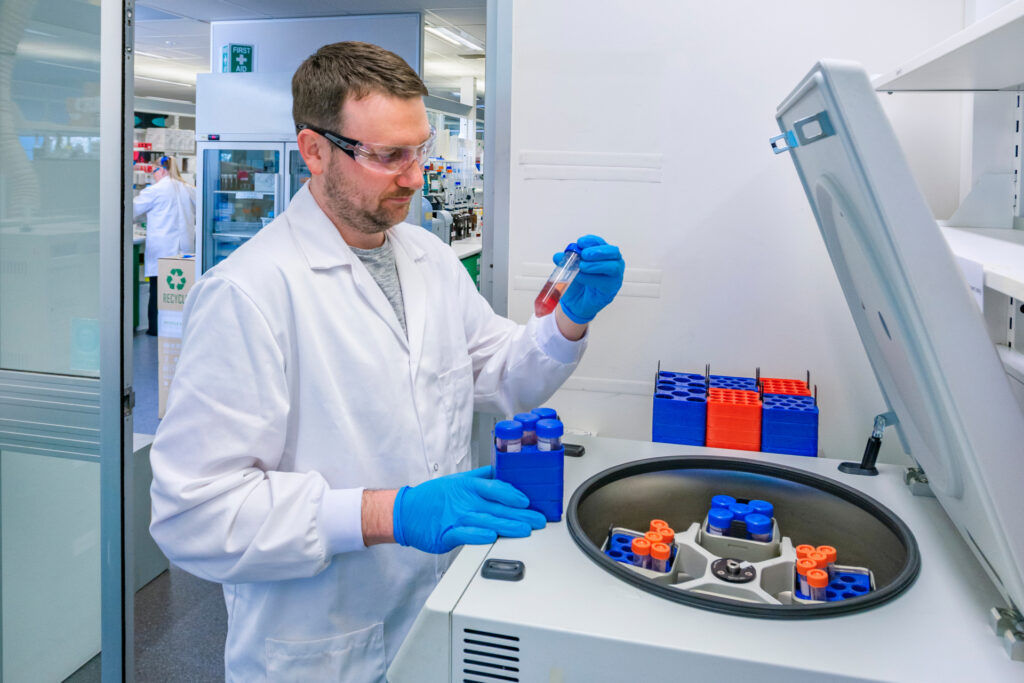End of ferment panel
The End of ferment panel bundles together eight common analyses used by winemakers to ensure the winemaking process is on the right track at the completion of primary and/or secondary fermentation, facilitating the next steps in the winemaking process such as racking and centrifuging. The nature of such samples can lead to issues when using technology such as WineScan, which means reference methods are required to achieve accurate results.
**Important safety note**
Ferment samples submitted in glass containers WILL NOT be accepted. Ferments must be submitted in plastic containers, preferably packed with a frozen cool pack, to limit pressure build-up resulting from uncontrolled fermentation. Samples will be processed at the discretion of Affinity Labs; any sample deemed to be unsafe will not be analysed.
Reportable results
Acetic acid
Volatile acidity as acetic acid is measured as acetic acid by enzymatic assay using a discrete analyser. Acetic acid makes up a large proportion of the volatile acidity and is used as the routine measure of volatile acidity. Acetic acid can also be measured using HPLC.
Alcoholic strength
The alcohol content in ferments is measured with an alcolyser using near infra-red technology. This infra-red method is fast and accurate and has been calibrated using distillation and densitometry.
Glucose + fructose
Glucose + fructose content in ferments is measured by enzymatic assay using a discrete analyser. This may also be measured in combination with organic acids by HPLC.
Malic acid
Malic acid content in ferments is measured by enzymatic assay using a discrete analyser. This analysis is generally used for monitoring the progress of malolactic fermentation during winemaking. The method is specific for L-malic acid, which is the naturally occurring isomer in grapes. It should be noted that commercial malic acid supplied to the wine industry as an acidulant, may contain D-malic acid in addition to, or instead of, L-malic acid. Analysis by HPLC in conjunction with enzymatic analysis will determine proportions of both D-malic and L-malic acid in samples.
Specific gravity
The density of ferments is measured using a density meter and converted to specific gravity.
pH
pH of ferments is analysed using a calibrated pH meter and combination electrode.
Titratable acid
Titratable acidity is measured on a degassed sample at the endpoint of 8.2 for Australian requirements and 7.0 to fulfil the requirements of the European Union. Both results are expressed as g/L tartaric acid. Tartaric acid can also be measured using HPLC.
WineScan panel
The WineScan Panel includes eight common analyses that provide routine wine composition information for winemakers during the latter stages of winemaking, from clarification, maturation, blending and filtration through to packaging.
The FOSS WineScan FT-2 spectrometer predicts alcohol, pH, specific gravity, total acidity, acetic acid, malic acid and glucose plus fructose in Australian finished wines from mid-infrared spectra using partial least-squares (PLS) chemometrics calibrations. This technique offers significant advantages over traditional laboratory methods in its speed and ability to predict multiple analytes simultaneously.
Note that for the purpose of WineScan analysis, finished wines are considered to have finished alcoholic fermentation and have undergone some form of clarification such as cold settling, racking, centrifugation or filtration.
New wines that have just finished alcoholic fermentation but might still be going through malolactic fermentation OR that have not been clarified (cold settled/racked/centrifuged etc.) are NOT suitable for analysis by FTIR WineScan. Please request the End of Ferment Panel analysis for these wine types.
Finished wines (considered ready for bottling) that fit the range of measurement in the table below (e.g. less than 30 g/L sugar) are suitable for analysis using the WineScan.
Malic acid analysis can be conducted on wine samples with acetic acid less than 1.34 g/L and turbidity less than 40 NTU. *Note that malic acid by WineScan is not covered by NATA accreditation.
| Analyte | Range or measurement | Units |
|---|---|---|
| Acetic acid | 0.25 – 1.34 | g/L |
| Alcohol | 10.0 – 16.5 | % v/v |
| Glucose + fructose | 0.0 – 30.0 | g/L |
| pH | 2.95 – 3.80 | – |
| Specific gravity | 0.9800 – 1.0000 | – |
| Titratable acidity (pH 7.0) | 4.3 – 7.7 | g/L |
| Titratable acidity (pH 8.2) | 4.8 – 8.2 | g/L |
| Malic acid | 0.4 – 3.0 | g/L |
Reportable results
Acetic acid
Volatile acidity as acetic acid is measured as acetic acid. Acetic acid makes up a large proportion of the volatile acidity and is used as the routine measure of volatile acidity. The calibration to predict acetic acid with FTIR technology has been developed using discrete analyser methods.
Alcoholic strength
The calibration to predict alcohol with FTIR technology has been developed using distillation and densitometry methods.
Glucose + fructose
The calibration to predict glucose + fructose with FTIR technology has been developed using discrete analyser methods.
Malic acid
The calibration to predict malic acid with FTIR technology has been developed using discrete analyser methods.
Specific gravity
The calibration to predict specific gravity with FTIR technology has been developed using densitometry methods.
pH
The calibration to predict pH with FTIR technology has been developed using a calibrated pH meter and combination electrode.
Titratable acid
Titratable acidity is measured at the endpoint of 8.2 for Australian requirements and 7.0 to fulfil the requirements of the European Union. Both results are expressed as g/L tartaric acid. The calibration to predict titratable acidity with FTIR technology has been developed using titration methods.
Ready to submit samples for analysis?
Complete the Wine and grapes laboratory analysis web form.
